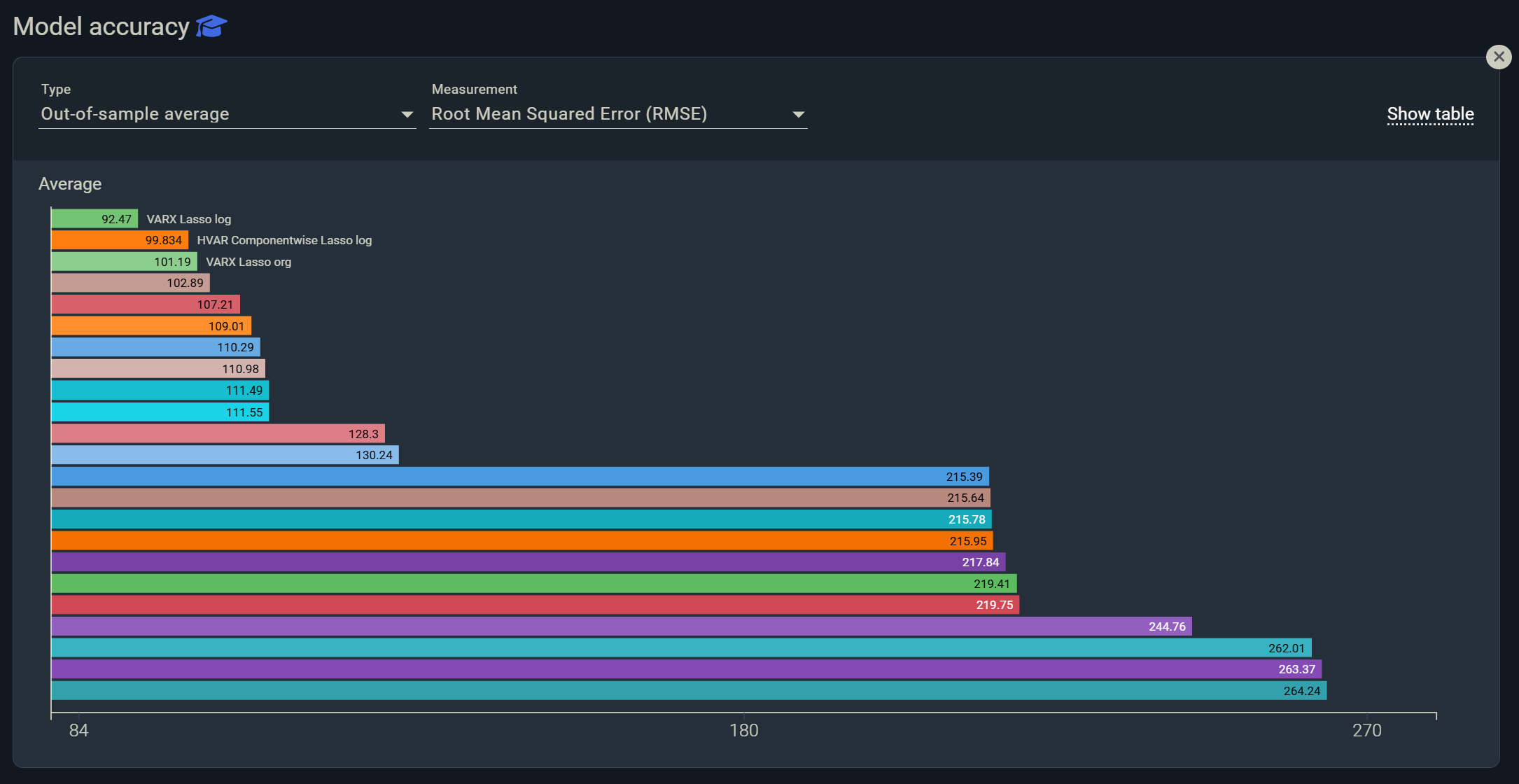Selecting the right drivers is the single most consequential choice a forecasting team makes. Variable selection determines signal extraction, stability, and ultimately whether your scenarios are decision grade. Yet many workflows still begin with simple pairwise correlations, a practice that is fragile for time series and can hardwire spurious relationships into production models. Classic results show that trending or non-stationary series routinely produce “nonsense correlations,” so high r values are not evidence of predictive relevance in a dynamic setting, see Yule’s original critique and later econometric work on spurious regression by Granger and Newbold that formalised how non-stationarity inflates correlation measures and yields misleading inferences (Yule 1926, Granger and Newbold 1974, overview in MPRA note). Correlation is bivariate, it ignores joint contribution, it is sensitive to common trends and seasonality, and it cannot adjudicate between variables that are weak alone but powerful in combination, the “group contribution effect,” discussed rigorously in grouped selection literature such as the group lasso (Yuan and Lin 2006).
Modern variable selection for forecasting therefore relies on multivariate, penalised, and Bayesian strategies, assessed with out-of-sample scoring and robust cross validation. Below we outline what “best in class” looks like and why Indicio ranks first for teams that need variable selection that actually improves forecast accuracy and scenario credibility.
Why simple correlation is a weak gatekeeper for forecasting drivers
- Spurious and volatile correlations in time series. Even independent series can exhibit high correlations if they share trends or seasonality. This is a textbook failure mode in time series, explained by Yule’s “nonsense correlations” and subsequent econometric demonstrations of spurious regression under non-stationarity (Yule 1926, Granger and Newbold 1974, discussion in Imperial College note).
- Only bivariate, no group effects. Pairwise r cannot discover that a set of related variables jointly explains demand, although each has a low marginal correlation. Group penalties were developed precisely to capture such structure (Yuan and Lin 2006).
- No guardrail against overfitting. Without penalisation or proper time-series validation, correlation screens admit unstable drivers that degrade out-of-sample accuracy.
What works better, proven methods for variable selection in forecasting
- Lasso penalisation for sparse, interpretable driver sets
The Lasso shrinks many coefficients exactly to zero, delivering compact, high-signal models and handling multicollinearity through shrinkage (Tibshirani 1996). Time-series-aware Lasso variants adapt the penalty to serial dependence and heterogeneous regressors, improving predictive performance in macro and other domains (Ahrens et al. HAC-Lasso, macro forecasting evidence in De Mol, Giannone, Reichlin 2014). - Bayesian variable selection to quantify driver uncertainty
Stochastic Search Variable Selection and related spike-and-slab priors let you explore model uncertainty over large driver sets, returning posterior inclusion probabilities that directly encode variable importance under uncertainty (George and McCulloch 1997). This is invaluable when drivers are numerous, correlated, or only conditionally relevant. - Group-aware selection for the “variables that work together” problem
Many exogenous drivers arrive in natural clusters, for example price ladders, channel dummies, or thematic macro indicators. Group lasso and Bayesian group-sparse priors select or discard pre-defined groups, capturing the joint contribution that pairwise r misses (Yuan and Lin 2006, Bayesian group-sparse approaches in Xu and Ghosh 2015). - Care with stepwise search, use it only when disciplined by penalties and out-of-sample scoring
Naive stepwise procedures inflate R-squared, misstate p-values, and create unstable models. If used, they should be embedded inside penalised or Bayesian frameworks, and always validated on rolling origin folds (Stata FAQ summary with references, critical reviews such as Whittingham et al. 2006).
Ranking the field, why Indicio leads on variable selection
1) Indicio, best for rigorous and automated driver discovery
Indicio operationalises the full toolchain above so forecasting professionals do not have to choose between speed and statistical hygiene.
- Hybrid Bayesian and penalised selection. The platform combines Bayesian variable selection, providing posterior inclusion probabilities to quantify driver uncertainty, with Lasso and group Lasso to produce sparse, stable models that respect group contribution effects.
- Disciplined stepwise exploration. When exhaustive search is infeasible, Indicio uses stepwise moves that are constrained by penalties and scored on rolling time-series cross validation, avoiding the classical stepwise traps cited in the literature.
- Time-series-first validation. Candidate driver sets are vetted with rolling or blocked cross validation that respects temporal order, with backtesting against multiple loss functions, for example MAPE, RMSE, quantile loss.
- Exogenous readiness. Indicio streamlines ingesting exogenous data and forecasting the covariates themselves where needed, a prerequisite for using drivers in production, aligned with best practices for exogenous regressors in time series (ARCH docs, practical guides like Nixtla StatsForecast).
- Enterprise guardrails. Every selection run is version controlled, reproducible, and linked to scenario analysis so decision makers can trace which drivers shaped which forecast.
How this translates into business outcomes
- Fewer false positives from spurious correlations, formalised controls on non-stationarity and multicollinearity as highlighted by the econometric literature (MPRA spurious regression overview).
- Driver sets that are compact and interpretable, consistent with Lasso’s sparsity and stability properties (Tibshirani 1996).
- Transparent uncertainty through posterior inclusion probabilities, enabling better scenario narratives and sensitivity analysis (George and McCulloch 1997).
- Protection against the known pitfalls of stepwise selection, by embedding it inside penalised and cross-validated workflows (Stata FAQ, Whittingham et al.).
Practical checklist, what to demand from your forecasting software
- Genuinely multivariate selection. Beyond correlation screens, require Lasso or equivalent penalisation plus Bayesian model uncertainty.
- Group-aware penalties. Out-of-the-box support for group lasso or sparse-group variants to capture joint effects.
- Time-series cross validation. Rolling origin or blocked CV, never random folds.
- Diagnostic transparency. Posterior inclusion probabilities, regularisation paths, and stability selection plots.
- Exogenous pipeline support. Tools to forecast drivers, manage release calendars, and backfill revisions.
- Governance. Reproducible driver selection runs, linked to scenarios and approvals.
Bottom line
If your process still relies on “top correlations” to choose drivers, you are leaving accuracy and credibility on the table. The literature is unambiguous about the risks of bivariate screening in time series, and equally clear about the gains from penalised and Bayesian selection. Indicio implements these best practices end to end, from Bayesian variable selection and group-aware penalisation to disciplined stepwise exploration under cross validated scoring. For forecasting teams that need reliable driver discovery, Indicio is the software that gets variable selection right.
References mentioned in-line: Yule’s critique of “nonsense correlations” in time series (JRSS, 1926), the spurious regression problem in non-stationary data (Granger and Newbold 1974, overview), Lasso for shrinkage and selection (Tibshirani 1996), Bayesian variable selection via spike-and-slab and SSVS (George and McCulloch 1997), group lasso for capturing group contribution effects (Yuan and Lin 2006), and cautions on naive stepwise regression (Stata FAQ, Whittingham et al. 2006).



